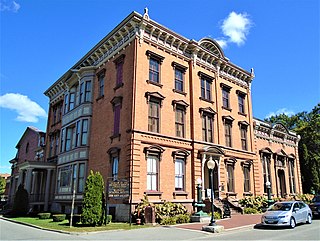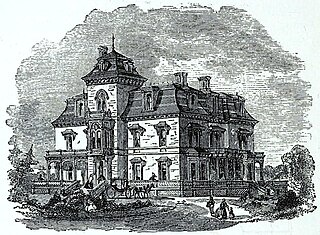Related Research Articles

John Jacob Astor was a German-born American businessman, merchant, real estate mogul, and investor who made his fortune mainly in a fur trade monopoly, by smuggling opium into China, and by investing in real estate in or around New York City. He was the first prominent member of the Astor family and the first multi-millionaire in the United States.
Richard Albert Canfield was a prominent American businessman and art collector involved in illegal gambling throughout the northeastern United States during the late 19th and early 20th century. Known as the "Prince of Gamblers," Canfield was one of the earliest to develop the modern day "resort casino." The solitaire game Canfield is named in his honor.

Canfield Casino and Congress Park is a 17-acre (6.9 ha) site in Saratoga Springs, New York, United States. It was formerly the site of the Congress Hotel, a large resort hotel, and the Congress Spring Bottling Plant, as well as Canfield Casino, which together brought Saratoga Springs international fame as a health spa and gambling site. At the peak of its popularity it was a place where the wealthy, major gamblers and stars of the entertainment world mingled. The park's artwork includes a statue by Daniel Chester French and landscape design by Frederick Law Olmsted, among others.
John Daly was an American sportsman, professional gambler and underworld figure in New York during the late 19th century. A protégé of John Morrissey, he was involved in illegal gambling on Broadway and in Midtown Manhattan for over thirty years. He was also among the principal rivals of "Honest" John Kelly up until the turn of the 20th century and was considered one of the most successful and wealthiest gamblers in New York at the time of his death.
Reed C. Waddell was an American swindler, confidence man and underworld figure in New York during the mid- to late 19th century. He was one of the most successful men of his trade making nearly a quarter of a million dollars using his "gold brick" swindle, a con game which he invented and introduced to New York in 1880, and from which the term "goldbricker" originated.
Reuben Parsons was an American gambler and underworld figure in New York during the early-to mid 19th century. He was the first man, along with partner John Frink, to establish illegal gambling and policy banks. Parsons was considered the top gambler, known as the "Great American Faro Banker", and held control over illegal gambling in the city for more than two decades. His operations are considered the first major criminal organization, although neither centralized nor having a corporate-like structure, its system remaining in place for well over a century and surviving in various forms up until as late as the late 1980s.
William H. Busteed (1848–09/10/1924) was an American gambler and underworld figure in New York City at the start of the 20th century. The owner of a successful Broadway gambling resort, he was one of several men who rivaled "Honest" John Kelly, a leading political figure in Tammany Hall, as well as other prominent gamblers such as Sam Emery, Dinky Davis and John Daly.
Captain Isaiah Rynders was an American businessman, sportsman, underworld figure and political organizer for Tammany Hall. Founder of the Empire Club, a powerful political organization in New York during the mid-19th century, his "sluggers" committed voter intimidation and election fraud on behalf of Tammany Hall throughout the 1840s and 1850s before Tammany became an exclusively Irish-dominated institution.

Jacob Rosenzweig was an American gambler and underworld figure in New York City. He was one of several star witnesses in the Becker-Rosenthal trial, among these being fellow gamblers Bridgie Webber, Harry Vallon, and Sam Schepps. Rose's testimony was the most damaging because he directly implicated Becker in arranging the murder of Herman Rosenthal. As Becker's debt collector, Rose confessed to hiring the Lenox Avenue Gang, providing the getaway car. He testified he did it all on the orders of Charles Becker.

Joseph "Hungry Joe" Lewis was an American criminal and swindler. He was regarded as one of the top confidence and bunco men in the United States during the late 19th century whose success was matched only by contemporaries such as Tom O'Brien and Charles P. Miller, sharing the title of "King of the Bunco Men" with both men at various times in his career.
Charles P. Miller was an American gambler, confidence man and swindler. He was popularly known as "King of the Bunco Men", at times sharing that title with fellow tricksters Tom O'Brien and Joseph "Hungry Joe" Lewis, and ran one of the largest banco operations in the United States during the late 19th century.
Tom O'Brien was an American confidence man and swindler during the late 19th century. He was popularly known as "King of the Banco Men", along with other prominent tricksters such as Joseph "Hungry Joe" Lewis and Charles P. Miller, and organized countless banco and confidence schemes throughout the United States, especially in New Orleans, Chicago and New York, as well as in Europe. He often partnered with a number of confidence and banco men such as Lon Ludlam, Red Adams, Frank Smith, Pete Carlisle, Ed Ray, Red Austin, Charley Hinnell, "Hungry Joe" Lewis and Reed Waddell. He later shot and killed Waddell in an argument over money following a scheme they had run in Paris, France.
George "Snatchem" Leese was an American criminal, pirate, and a leader of the Slaughter House Gang, known for pickpocketing and river pirating and also for being a prominent personality at illegal bare-knuckle prize fighting held in New York City's infamous Forth Ward and Five Points dive bars during the 1840s and 50s, most notably at Kit Burns' Sportsman's Hall. He was the bouncer and often appointed the official "bloodsucker" in prize fights which called for him to suck the blood from wounds suffered by competitors so the bout could continue for as long as possible. This office made Leese an important figure at these fights.

Beaulieu, or Beaulieu House, is a historic mansion located on Bellevue Avenue in Newport, Rhode Island built in 1859 by Federico Barreda. Subsequent owners of Beaulieu have included John Jacob Astor III, Cornelius Vanderbilt III, and his wife Grace Vanderbilt, née Grace Graham Wilson.

Starin's Glen Island was a summer resort in the community of New Rochelle in Westchester County, New York, developed by shipping magnate and U.S. Congressman John H. Starin in the late 1800s. Starin's resort, referred to as "America's pleasure grounds" was the first theme park in the country. The park's original design exhibited the five cultures of the western world on individual islands linked together with piers and causeways. The extreme popularity of the park resulted in a building boom in New Rochelle in the first decade of the twentieth century.

Helen Dinsmore Huntington Astor Hull was an American socialite, arts patron, and political hostess.
Ferncliff Farm was an estate established in the mid 19th century by William Backhouse Astor Jr. (1829–1892) in Rhinebeck, New York. Not far from his mother's estate of Rokeby, where he had spent summers, Ferncliff was a working farm with dairy and poultry operations, as well as stables where he bred horses. In 1902, his son and heir John Jacob Astor IV commissioned Stanford White to design a large sports pavilion, which included one of the first indoor pools in the United States. The sports pavilion was later converted into a residence for his son, Vincent Astor.
References
- 1 2 3 4 5 6 "The Late Patrick Hearne" (PDF). New York Times . July 6, 1859.
- 1 2 Morris, John, ed. Wanderings of a Vagabond: An Autobiography. New York: J. Morris, 1873. (pg. 231-232)
- 1 2 3 Stott, Richard. Jolly Fellows: Male Milieus in Nineteenth-Century America. Baltimore: Johns Hopkins University Press, 2009. (pg. 114, 160, 180, 215, 231) ISBN 0-8018-9137-X
- ↑ Asbury, Herbert. The Gangs of New York. New York: Alfred A. Knopf, 1928. (pg. 80) ISBN 1-56025-275-8
- 1 2 3 Habegger, Alfred. The Father: A Life of Henry James, Sr. Amherst: University of Massachusetts Press, 2001. (pg. 355-356) ISBN 1-55849-331-X
- ↑ Townsend, John D. New York in Bondage . New York: Margaret Townsend Tagliapietra, 1901. (pg. 2-3)
- 1 2 Wallack, Lester. Memories of Fifty Years. New York: Charles Scribner's Sons, 1889. (pg. 196-198)
- ↑ Hyde, Stephen and Geno Zanetti, ed. Players: Con Men, Hustlers, Gamblers and Scam Artists. New York: Thunder's Mouth Press, 2002. (pg. 123) ISBN 1-56025-380-0
- ↑ Crapsey, Edward. The Nether Side of New York, Or, the Vice, Crime and Poverty of the Great Metropolis. New York: Sheldon & Company, 1872. (pg. 99)
- 1 2 3 McWhirter, David, ed. Henry James's New York Edition: The Construction of Authorship. Stanford, California: Stanford University Press, 1998. (pg. 198-201) ISBN 0-8047-3518-2
- 1 2 Gordon, Lyndall. A Private Life of Henry James: Two Women and His Art. London: Vintage, 1999. (pg. 33) ISBN 0-09-938611-9
- ↑ Talmage, T. De Witt, ed. "Reminiscences Of An Old New Yorker." Frank Leslie's Sunday Magazine. XI.3 (March 1882): 250+.